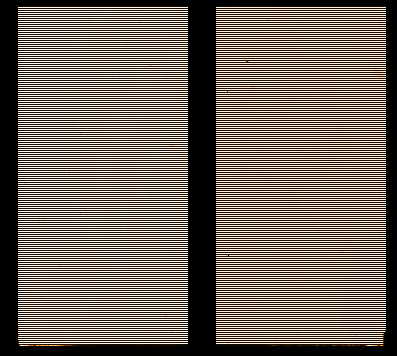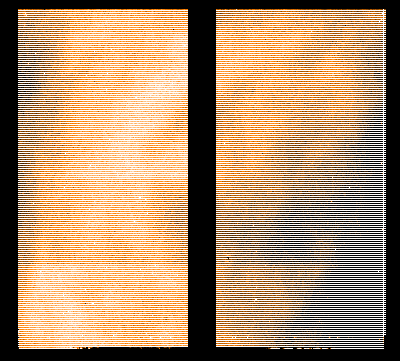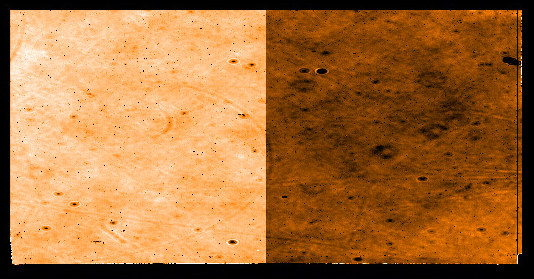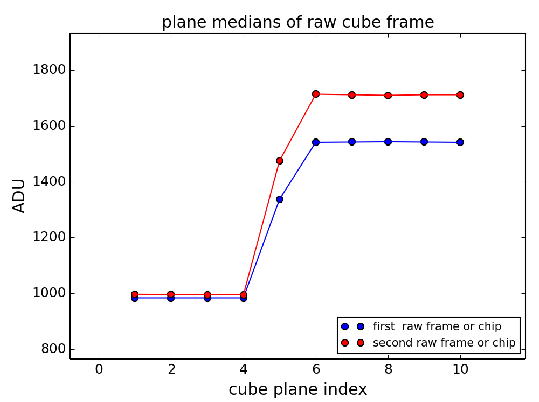SPHERE: ZIMPOL flat frames
| |
| HC PLOTS |
| raw flat counts imaging |
 |
| signal-to-noise ratio imaging |
 |
| rms of master flat imaging |
 |
| illumination stability imaging |
 |
|
QC1 database (advanced users):
browse |
plot
|
| raw flat counts polarimetry V filter |
 |
| raw flat counts polarimetry N_R filter |
 |
| raw flat counts polarimetry N_I filter |
 |
| signal-to-noise ratio polarimetry V filter |
 |
| signal-to-noise ratio polarimetry N_R filter |
 |
| signal-to-noise ratio polarimetry N_I filter |
 |
| rms of master flat polarimetry V filter |
 |
| rms of master flat polarimetry N_R filter |
 |
| rms of master flat polarimetry N_I filter |
 |
| illumination stability polarimetry V filter |
 |
| illumination stability polarimetry N_R filter |
 |
| illumination stability polarimetry N_I filter |
 |
|
QC1 database (advanced users):
browse |
plot
|
ZIMPOL flat frames are taken during day time using the same readmode
and broadband filter as the science observations. Narrowband filter
science observations are calibrated with broadband filter flats of
closest wavelength. Raw flats come as single files with one extension
per CCD. Each extension is a data cube (NAXIS=3) with NDIT=NAXIS3
planes/layers. ZIMPOL product frames come as one file per CCD with
several extensions each.
 |
ZIMPOL raw flat frame (one plane of the cube) in StandardImaging readmode of one CCD (here CAM1).
|
 |
ZIMPOL raw flat frame (first raw frame extension corresponding to chip1 = Callas) from above with cuts = 5800-6000 ADU to highlight the flat level and its structure in the odd rows of the CCD containing the lamp signal.
|
 |
ZIMPOL raw flat frame from above with cuts = 1100-1200 ADU to highlight the flat level and its structure in the even rows of the CCD. The signal is composed of the bias level plus some scattered light.
|
 |
ZIMPOL flat product frame. IFRAME extension showing the master flat based on the odd rows of the raw frame for CAM1 with the illuminated.
|
 |
ZIMPOL flat product frame. PFRAME extension, showing the master flat based on the even rows of the raw frame for CAM1 carrying a bias signal.
|
 ZIMPOL Flat counts
ZIMPOL Flat counts
QC1_parameters
| FITS key |
QC1 database: table, name |
definition |
class* |
HC_plot** |
more docu |
| DRS.DOUBLE.IMAGE.IFRAME.RAW.MED.MEDIAN | sphere_zimpol_iflat_img..qc_iframe_raw_med | med counts in raw image frame | HC |  | [docuSys coming] |
| DRS.ZERO.ODD.RAW.MED.MEDIAN | sphere_zimpol_iflat_pol..qc_rawmed_zero_odd | polphase zero, odd cycle | HC |  | [docuSys coming] |
*Class: KPI - instrument performance; HC - instrument health; CAL - calibration quality; ENG - engineering parameter
**There might be more than one. |
Trending
The raw frame counts (not bias-subtracted ~1000 ADU) are monitored for
StandardImaging readmode
in three broad band filters V, N_I and N_R and both detectors for the illuminayed cycle only.
It is also monitored for SlowPolarimetry
and FastPolarimetry readmode for both detectors and
the zero odd cycle for the same three broad band filters.
Scoring&thresholds ZIMPOL Flat counts
The QC parameter is scored with lower thresholds of 5000 ADU and upper thresholds of 55000 ADU to flag potiential saturation at 65535 ADU.
History
| Date |
event |
| 2018-06 | lamp counts begin to decrease |
| 2018-07-29T16:28 | LAMP_QL1 is used instead of LAMP_QL2 |
Algorithm ZIMPOL Flat counts
The average counts of all zero-odd sub-planes of the raw cube frame is taken.
 ZIMPOL Flat SN ratio
ZIMPOL Flat SN ratio
QC1_parameters
| FITS key |
QC1 database: table, name |
definition |
class* |
HC_plot** |
more docu |
| [derived from a QC procedure] | sphere_zimpol_iflat_img..qc_SNR_iframe | signal-to-noise ratio of image frame | HC |  | [docuSys coming] |
| [derived from a QC procedure] | sphere_zimpol_iflat_pol..qc_SNR_zero_odd | polphase zero, odd cycle | HC |  | [docuSys coming] |
*Class: KPI - instrument performance; HC - instrument health; CAL - calibration quality; ENG - engineering parameter
**There might be more than one. |
Trending
The signal-to-noise ratios are monitored for
StandardImaging readmode
in three broad band filters V, N_I and N_R and both detectors for the illuminated cycle only.
It is also monitored for SlowPolarimetry
and FastPolarimetry readmode for both detectors and
the zero odd cycle for the same three broad band filters.
Scoring&thresholds ZIMPOL Flat SN ratio
The QC parameter is scored with lower thresholds of 200, corresponding to 0.5% photon noise.
(For narrow band filters the minimum SN-ratio is 100 due to operational reasons)
History
2018-11: flat frames can contain DIT values smaller than
the technical possible minimum DIT (10sec for SlowPol
and 1.1 for StandardImg and FastPol). This was fixed in 2018-11.
Most of the QC parameters from early calibrations are affected, they have not been reprocessed.
Algorithm ZIMPOL Flat SN ratio
The average counts of all zero-odd sub-planes of the raw cube frame is taken.
The sqrt of NDIT times these counts is the signal-to-noise ratio
 ZIMPOL Flat RMS
ZIMPOL Flat RMS
QC1_parameters
| FITS key |
QC1 database: table, name |
definition |
class* |
HC_plot** |
more docu |
| QC.DOUBLE.IMAGE.IFRAME.RMS | sphere_zimpol_iflat_img..qc_rms_iframe | rms of counts image frame | HC |  | [docuSys coming] |
| QC.QUAD.IMAGE.ZERO.ODD.RMS | sphere_zimpol_iflat_pol..qc_rms_zero_odd | polphase zero, odd cycle | HC |  | [docuSys coming] |
*Class: KPI - instrument performance; HC - instrument health; CAL - calibration quality; ENG - engineering parameter
**There might be more than one. |
Trending
The master flat rms values are monitored for
StandardImaging readmode
in three broad band filters V, N_I and N_R and both detectors for the illuminated cycle only.
It is also monitored for SlowPolarimetry
and FastPolarimetry readmode for both detectors and
the zero odd cycle for the same three broad band filters.
Scoring&thresholds ZIMPOL Flat RMS
The QC parameter is scored with thresholds based on statistical arguments.
History
No Remarks.
Algorithm ZIMPOL Flat RMS
The RMS of the master flat is taken.
 ZIMPOL Flat shutter
ZIMPOL Flat shutter
QC1_parameters
| FITS key |
QC1 database: table, name |
definition |
class* |
HC_plot** |
more docu |
| [derived from QC procedure] | sphere_zimpol_iflat_img..qc_plane_rms | rms of raw cube plane median | HC |  | [docuSys coming] |
| [derived from QC procedure] | sphere_zimpol_iflat_pol..qc_plane_rms | rms of raw cube plane median | HC |  | [docuSys coming] |
*Class: KPI - instrument performance; HC - instrument health; CAL - calibration quality; ENG - engineering parameter
**There might be more than one. |
Trending
The readout noise is trended for both chips (CAM1, CAM2 = Callas, Bartoli) and for all three read modes.
Scoring&thresholds ZIMPOL Flat shutter
The QC parameter is scored with an upper threshold of 4 ADU.
History
Since 2015-09-09 some but not all ZIMPOL lamp flats as well as ZIMPOL
modemeff calibrations and optical distortion pinhole images calibrations
suffer from the following effect: The first or more planes (the first
detector read outs) of the raw frame data cube suffer from having not
lamp counts or considerably less counts than the remaining readouts in
the data cube.
 |
The Fig. shows the median counts of the V-band imaging flats, resolved per plane of the raw frame data cube. The first four planes are not illiminated with a bias level of ~1000 ADU. Only planes 6 to 10 are fully illuminated. Blue points are from channel 1 (CAM1, Callas) and the red points are from channel 2 (CAM2, Bartoli).
|
Since the number of unilluminated planes varies it is not known how
the data reduction recipe behaves in this situation. Master flats and
modemeff frames are only processed for reasons to monitor the behaviour
via the qc_plane_rms QC parameter, but products are discarded thereafter
again. The corresponding health check plots are taken off the main page
and are available here (WH 2016-04-14): flats imaging mode
The problem is solved in 2016-06.
Algorithm ZIMPOL Flat shutter
The median counts is retrieved for any plane of the raw frame data
cube. The rms of the sample is derived. This QC parameter measures if
all planes of the cube are illuminated or if some planes are affected
by the shutter problem.

|
 mirror sites:
PL (internal link)
HQ
[?]
mirror sites:
PL (internal link)
HQ
[?]
 ZIMPOL Flat counts
ZIMPOL Flat counts
 ZIMPOL Flat SN ratio
ZIMPOL Flat SN ratio
 ZIMPOL Flat RMS
ZIMPOL Flat RMS
 ZIMPOL Flat shutter
ZIMPOL Flat shutter






